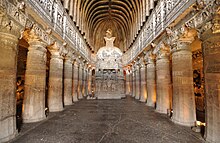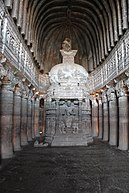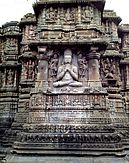Marathwada
 Clockwise from top : Kailasa Temple, Shri Hazoor Sahib Gurudwara, Chaitya Griha or prayer hall at Ajanta Caves | |
| Districts | Aurangabad, Beed, Hingoli, Jalna, Latur, Nanded, Osmanabad, Parbhani |
|---|---|
| Largest city | Aurangabad |
| Division | Aurangabad division |
| Area | 64,590 km2 (24,940 sq mi) |
| Population (2011) | 18,731,872[1] |
| Density (per km2) | 354[1] |
| Literacy | 76.27%[1] |
| Sex Ratio | 932[1] |
Marathwada (Marathi pronunciation: ).
Marathwada is known for its struggle for merger in the Maharashtra state, which is commemorated on 17 September as Marathwada Mukti Sangram Din.
Etymology
The term Marathwada means the house of Marathi speaking people, that is land occupied by the Marathi-speaking population of the former
Demographics
Marathwada has total area of 64590 km2 and had a population of 18,731,872 at the 2011 census of India.[3][a]
Languages
At the time of the
Religion
Hinduism is the majority religion in Marathwada, with Islam and Buddhism being significant minorities. Sikhism has a significant presence in Nanded, meanwhile Jains are present in urban areas of Marathwada such as Aurangabad, Jalna and Osmanabad.
At the time of the
Religion in Marathwada (2011)[5]
Under Nizams rule
The region of Hingoli and Aurangabad were a major hub for the military stations and depot during the time of
Temporary guest houses were built for Sikh devotees in Nanded which lies in ruins due to neglect by the government authorities. Also roads connecting to Ahmedabad were initiated.[6]
Cities and districts
Major cities of Marathwada region
All the cities below have population of more than 100,000 with Aurangabad having 1.1 million inhabitants per the 2011 census.
Districts
There are
Tourism



The state government recognises Aurangabad as the "Tourism Capital of Maharashtra".[10] There are various tourist attractions in Aurangabad. Other places visited by tourists are:
- Ajanta Caves
- Ellora Caves
- Bibi Ka Maqbara
- Daulatabad
- Hazur Sahib Nanded
- Udgir Fort
- Ausa
- Dharashiv Caves
- Aundha Nagnath
- Mahur
- Kandhar
- Grishneshwar Temple
- Parli
- Tuljapur
- Dharur, Beed
- Jamb Samarth, Jalna district
- Kali Masjid
- Nanded Fort
- Sahasrakund Waterfall
Education

Marathwada has four government medical colleges, situated at Aurangabad, Latur, Nanded and Ambajogai. The region also has good government engineering colleges such as SGGS Nanded, Aurangabad Government Engineering College. It also has three major universities, being
The foundation of agricultural research in Marathwada region of
Droughts and suicide of farmers
Marathwada is affected by frequent anomalies in rainfall during Monsoon season, which accounts for almost 80 percent of the annual rainfall. The average annual rainfall over the division is 882 mm. Almost three-fourths of the Marathwada division is covered by farmlands. Hence, drought continues to have a considerable impact on the life of farmers.[11]
In some Marathwada districts recurring droughts have forced people to drink fluoride-contaminated groundwater from borewells which has inflicted debilitating fluorosis on many.[12]
The region also sees high instances of farmer suicides. According to government records, 422 farmers in Marathwada committed suicide in 2014. This was because of their inability to bear crop losses and a financial quandary made acute by water scarcity and an agrarian crisis.[13] 2014 was the third consecutive year of low rainfall, and when rainfall did occur it was sometimes untimely and damaged crops. Of the 422 suicides, 252 cases were due to an inability to repay agricultural loans. There have been more than 117 farmer suicides in the first two months of 2017.[13] According to a study by IIT Bombay, the severe or extreme droughts have frequently occurred in major portions of Marathwada, in the last few decades.[11]
See also
- List of people from Marathwada
- Hyderabad State
- Nizam's Guaranteed State Railway
- Make in Maharashtra
- Manav Vikas Mission
References
Notes
- ^ Marathwada is not separate political or administrative entity so there is no reference of population by name of "Marathwada", population has been calculated by adding population of 8 districts of Marathwada.
- ^ Marathwada is not separate political or administrative entity so there is no reference of population by name of "Marathwada", population for each religion has been calculated by adding population of 8 districts of Marathwada.
Citations
- ^ a b c d "District wise Demography". Census 2011. Retrieved 23 May 2015.
- ISBN 978-8170990178.
- ^ "Maharashtra Population Census data 2011". Government of India. Retrieved 11 April 2015.
- ^ 2011 Census of India, Population By Mother Tongue
- ^ a b "Population By Religious Community" (XLSX). censusindia.gov.in. 2011.
- ^ a b "MAU". mkv. Archived from the original on 18 May 2015. Retrieved 24 May 2015.
- ^ "औरंगाबाद महानगरपालिका". Archived from the original on 29 March 2015. Retrieved 7 January 2015.
- ^ "NWCMC Home Page". Nwcmc.gov.in. Retrieved 29 May 2015.
- ^ "Index of /".
- ^ "World News Headlines". Newkerala.com. Retrieved 29 May 2015.
- ^ S2CID 26920225.
- ^ "Marathwada's troubled waters harm your bones". People's Archive of Rural India. 12 January 2018.
- ^ a b Jog, Sanjay (5 December 2014). "422 farmer suicides in 2014 in Marathwada gives BJP govt the jitters | Business Standard News". Business Standard India. Business-standard.com. Retrieved 29 May 2015.
Further reading
- Beyond Economic Development: A Case Study of Marathwada
- Vidarbha and Marathwada: Trapped in a vicious cycle -Hindustan Times
- Cane cultivation leaving Marathwada bone dry: Study -The Times of India
- Photo-essay on the 2016 drought in Marathwada
- Have India's farm suicides really declined? -BBC article
- In worst drought year, Marathwada emerges new suicide region -Indian Express
- 'Wrong method used to calculate Vidarbha, Marathwada backlog' - The Times of India
- Lucien D. Benichou (1 January 2000). From Autocracy to Integration: Political Developments in Hyderabad State, 1938-1948. Orient Blackswan. ISBN 978-81-250-1847-6.
- Human Development Report 2002 - Maharashtra (India)





